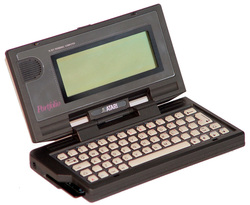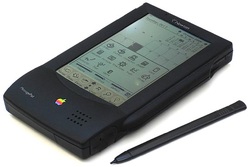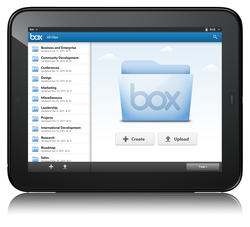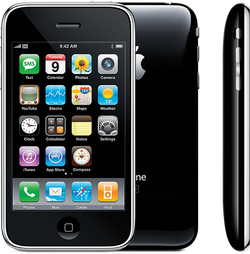One of the interesting things is looking at the evolution of mobile computing in terms of hand-held units.
- Pocket Computers (TRS80, Sharp, Panasonic)
- PalmTops (Atari Portfolio, HP200X)
- Personal Digital Assistants (PDA) – (Sharp, Compaq, Dell)
- Tablets (iPad, HP TouchPad, Android)
- SmartPhones (iPhone, Samsung Galaxy)
Pocket Computers
A pocket computer is a small calculator-sized handheld programmable computer. This specific category of computers existed primarily in the 1980s. Manufacturers included Casio, Hewlett-Packard, Sharp, Tandy/Radio Shack (Selling Casio and Sharp models under their own TRS line) and many more. The programming language was usually BASIC, but some devices offered alternatives. For example the Casio PB-2000 could be programmed in Assembly, BASIC, C, and Lisp.[1] An important feature of pocket computers was that all programming languages were available for the device itself, not downloaded from a cross-compiler on a larger computer.
[source: http://en.wikipedia.org/wiki/Pocket_computer]
A pocket computer is a small calculator-sized handheld programmable computer. This specific category of computers existed primarily in the 1980s. Manufacturers included Casio, Hewlett-Packard, Sharp, Tandy/Radio Shack (Selling Casio and Sharp models under their own TRS line) and many more. The programming language was usually BASIC, but some devices offered alternatives. For example the Casio PB-2000 could be programmed in Assembly, BASIC, C, and Lisp.[1] An important feature of pocket computers was that all programming languages were available for the device itself, not downloaded from a cross-compiler on a larger computer.
[source: http://en.wikipedia.org/wiki/Pocket_computer]
Collection includes:
- TSR80 Pocket Computer Model: PC-4
- TSR80 Pocket Computer Model: PC-2 + printer interface

PalmTops/Handheld PC
A handheld PC, or H/PC for short, is a computer built around a form factor which is smaller than any standard laptop computer. It is sometimes referred to as a palmtop. The first hand-held device compatible with desktop IBM personal computers of the time was the Atari Portfolio of 1989. Other early models were the Poqet PC of 1989 and the Hewlett Packard HP 95LX of 1991. Other DOS-compatible hand-held computers also existed.
[source: http://en.wikipedia.org/wiki/Palmtop_computer]
A handheld PC, or H/PC for short, is a computer built around a form factor which is smaller than any standard laptop computer. It is sometimes referred to as a palmtop. The first hand-held device compatible with desktop IBM personal computers of the time was the Atari Portfolio of 1989. Other early models were the Poqet PC of 1989 and the Hewlett Packard HP 95LX of 1991. Other DOS-compatible hand-held computers also existed.
[source: http://en.wikipedia.org/wiki/Palmtop_computer]
Collection includes:
- Atari Portfolio

Personal Digital Assistants (PDA)
A personal digital assistant (PDA), also known as a palmtop computer, or personal data assistant, is a mobile device that functions as a personal information manager. PDAs are largely considered obsolete with the widespread adoption of smartphones. A PDA has an electronic visual display, enabling it to include a web browser, all current models also have audio capabilities enabling use as a portable media player, and also enabling most of them to be used as mobile phones. Most PDAs can access the Internet, intranets or extranets via Wi-Fi or Wireless Wide Area Networks. Most PDAs employ touchscreen technology. The first PDA was released in 1984 by Psion, the Organizer. Followed by Psion’s Series 3, in 1991, which began to resemble the more familiar PDA style. It also had a full keyboard. The term PDA was first used on January 7, 1992 by Apple Computer CEO John Sculley at the Consumer Electronics Show in Las Vegas, Nevada, referring to the Apple Newton. [source: http://en.wikipedia.org/wiki/Personal_digital_assistant]
A personal digital assistant (PDA), also known as a palmtop computer, or personal data assistant, is a mobile device that functions as a personal information manager. PDAs are largely considered obsolete with the widespread adoption of smartphones. A PDA has an electronic visual display, enabling it to include a web browser, all current models also have audio capabilities enabling use as a portable media player, and also enabling most of them to be used as mobile phones. Most PDAs can access the Internet, intranets or extranets via Wi-Fi or Wireless Wide Area Networks. Most PDAs employ touchscreen technology. The first PDA was released in 1984 by Psion, the Organizer. Followed by Psion’s Series 3, in 1991, which began to resemble the more familiar PDA style. It also had a full keyboard. The term PDA was first used on January 7, 1992 by Apple Computer CEO John Sculley at the Consumer Electronics Show in Las Vegas, Nevada, referring to the Apple Newton. [source: http://en.wikipedia.org/wiki/Personal_digital_assistant]
Collection includes:
- Apple Newton
- Sharp Zaurus
- Handspring
- Dell Axim

Tablets
A tablet computer, or simply tablet, is a mobile computer with display, circuitry and battery in a single unit. Tablets are equipped with sensors, including cameras, microphone, accelerometer and touchscreen, with finger or stylus gestures replacing computer mouse and keyboard. Tablets may include physical buttons, e.g., to control basic features such as speaker volume and power and ports for network communications and to charge the battery. An on-screen, pop-up virtual keyboard is usually used for typing. Tablets are typically larger than smart phones or personal digital assistants at 7 inches (18 cm) or larger, measured diagonally. Hybrids that include detachable keyboards have been sold since the mid-1990s. Convertible touchscreen notebook computers have an integrated keyboard that can be hidden by a swivel or slide joint. Booklet tablets have dual-touchscreens and can be used as a notebook by displaying a virtual keyboard on one of the displays.
Collection includes:
A tablet computer, or simply tablet, is a mobile computer with display, circuitry and battery in a single unit. Tablets are equipped with sensors, including cameras, microphone, accelerometer and touchscreen, with finger or stylus gestures replacing computer mouse and keyboard. Tablets may include physical buttons, e.g., to control basic features such as speaker volume and power and ports for network communications and to charge the battery. An on-screen, pop-up virtual keyboard is usually used for typing. Tablets are typically larger than smart phones or personal digital assistants at 7 inches (18 cm) or larger, measured diagonally. Hybrids that include detachable keyboards have been sold since the mid-1990s. Convertible touchscreen notebook computers have an integrated keyboard that can be hidden by a swivel or slide joint. Booklet tablets have dual-touchscreens and can be used as a notebook by displaying a virtual keyboard on one of the displays.
Collection includes:
- Android
- HP TouchPad

SmartPhones
A smartphone (or smart phone) is a mobile phone with more advanced computing capability and connectivity than basic feature phones. Early smartphones typically combined the features of a mobile phone with those of another popular consumer device, such as a personal digital assistant (PDA), a media player, a digital camera, and/or a GPS navigation unit. Later smartphones include all of those plus the features of a touchscreen computer, including web browsing, Wi-Fi, and 3rd-party apps.
[source: http://en.wikipedia.org/wiki/Smartphone]
A smartphone (or smart phone) is a mobile phone with more advanced computing capability and connectivity than basic feature phones. Early smartphones typically combined the features of a mobile phone with those of another popular consumer device, such as a personal digital assistant (PDA), a media player, a digital camera, and/or a GPS navigation unit. Later smartphones include all of those plus the features of a touchscreen computer, including web browsing, Wi-Fi, and 3rd-party apps.
[source: http://en.wikipedia.org/wiki/Smartphone]
Collection includes:
- Apple iPhone 3
- Samsung Galaxy 3

Appreciate you blogging thhis